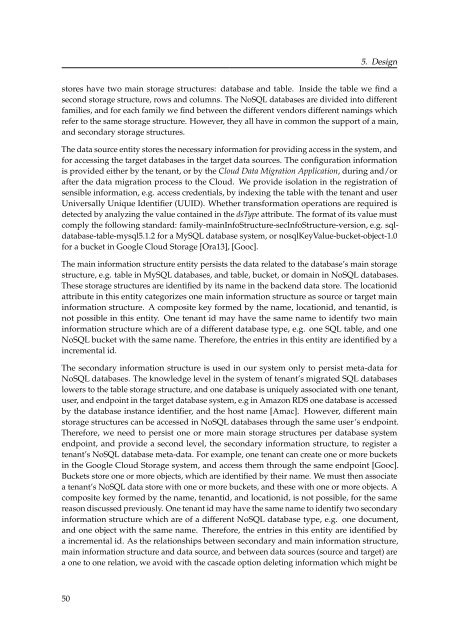Diploma Thesis Santiago Gómez Sáez - IAAS
Diploma Thesis Santiago Gómez Sáez - IAAS
Diploma Thesis Santiago Gómez Sáez - IAAS
You also want an ePaper? Increase the reach of your titles
YUMPU automatically turns print PDFs into web optimized ePapers that Google loves.
5. Design<br />
stores have two main storage structures: database and table. Inside the table we find a<br />
second storage structure, rows and columns. The NoSQL databases are divided into different<br />
families, and for each family we find between the different vendors different namings which<br />
refer to the same storage structure. However, they all have in common the support of a main,<br />
and secondary storage structures.<br />
The data source entity stores the necessary information for providing access in the system, and<br />
for accessing the target databases in the target data sources. The configuration information<br />
is provided either by the tenant, or by the Cloud Data Migration Application, during and/or<br />
after the data migration process to the Cloud. We provide isolation in the registration of<br />
sensible information, e.g. access credentials, by indexing the table with the tenant and user<br />
Universally Unique Identifier (UUID). Whether transformation operations are required is<br />
detected by analyzing the value contained in the dsType attribute. The format of its value must<br />
comply the following standard: family-mainInfoStructure-secInfoStructure-version, e.g. sqldatabase-table-mysql5.1.2<br />
for a MySQL database system, or nosqlKeyValue-bucket-object-1.0<br />
for a bucket in Google Cloud Storage [Ora13], [Gooc].<br />
The main information structure entity persists the data related to the database’s main storage<br />
structure, e.g. table in MySQL databases, and table, bucket, or domain in NoSQL databases.<br />
These storage structures are identified by its name in the backend data store. The locationid<br />
attribute in this entity categorizes one main information structure as source or target main<br />
information structure. A composite key formed by the name, locationid, and tenantid, is<br />
not possible in this entity. One tenant id may have the same name to identify two main<br />
information structure which are of a different database type, e.g. one SQL table, and one<br />
NoSQL bucket with the same name. Therefore, the entries in this entity are identified by a<br />
incremental id.<br />
The secondary information structure is used in our system only to persist meta-data for<br />
NoSQL databases. The knowledge level in the system of tenant’s migrated SQL databases<br />
lowers to the table storage structure, and one database is uniquely associated with one tenant,<br />
user, and endpoint in the target database system, e.g in Amazon RDS one database is accessed<br />
by the database instance identifier, and the host name [Amac]. However, different main<br />
storage structures can be accessed in NoSQL databases through the same user’s endpoint.<br />
Therefore, we need to persist one or more main storage structures per database system<br />
endpoint, and provide a second level, the secondary information structure, to register a<br />
tenant’s NoSQL database meta-data. For example, one tenant can create one or more buckets<br />
in the Google Cloud Storage system, and access them through the same endpoint [Gooc].<br />
Buckets store one or more objects, which are identified by their name. We must then associate<br />
a tenant’s NoSQL data store with one or more buckets, and these with one or more objects. A<br />
composite key formed by the name, tenantid, and locationid, is not possible, for the same<br />
reason discussed previously. One tenant id may have the same name to identify two secondary<br />
information structure which are of a different NoSQL database type, e.g. one document,<br />
and one object with the same name. Therefore, the entries in this entity are identified by<br />
a incremental id. As the relationships between secondary and main information structure,<br />
main information structure and data source, and between data sources (source and target) are<br />
a one to one relation, we avoid with the cascade option deleting information which might be<br />
50

















